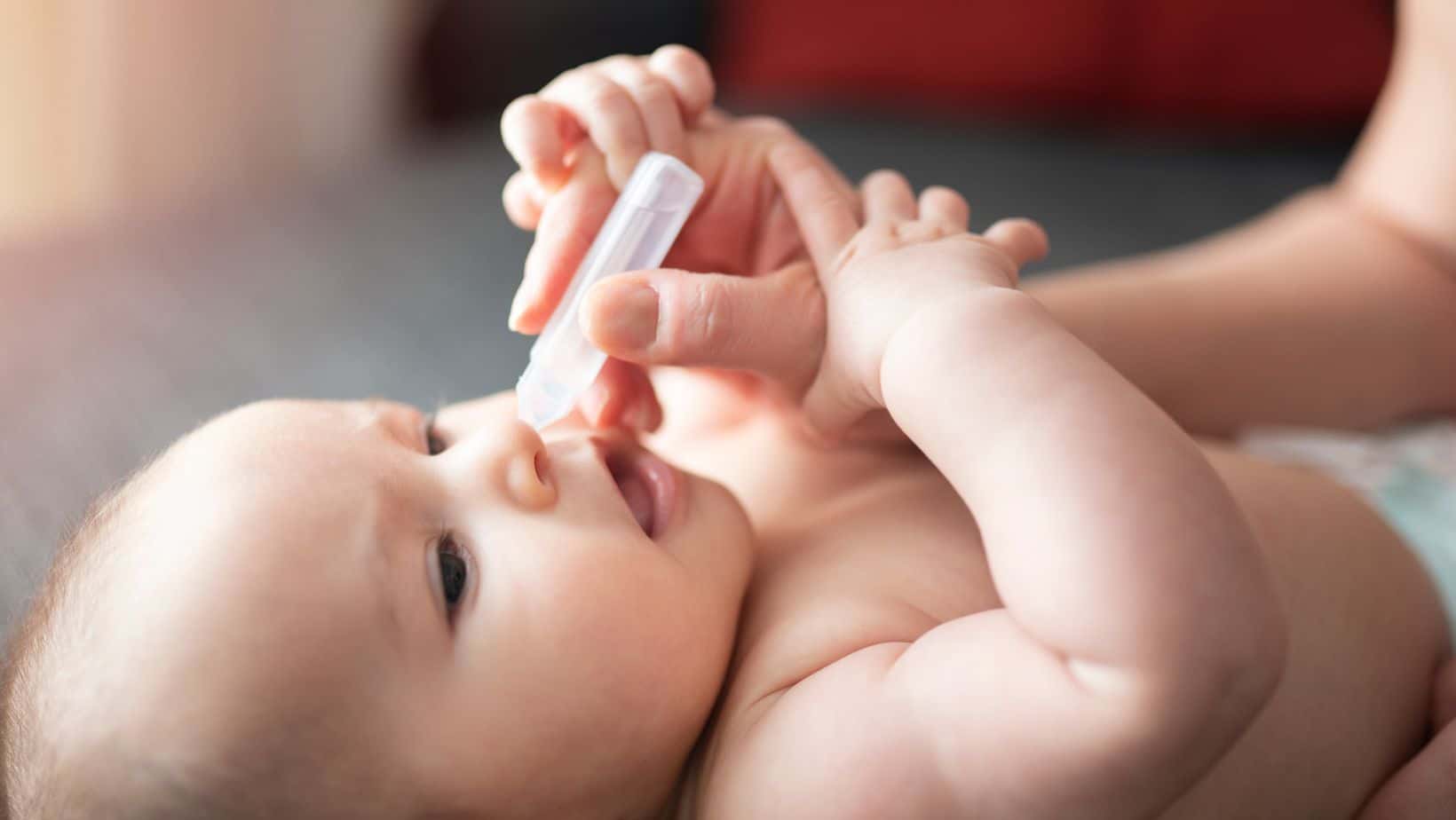How to blow baby’s nose? Which baby flyer to choose and how to use it?
Many parents would like information on cleaning their baby’s nasal passages. Is it necessary to regularly use saline water for baby’s nose? Is it preferable to use a vial of physiological liquid, a mister or a spray with an ultra-delicate jet to moisturize the nose? Can a baby fly be used from birth? Is the Baby-Vac™ suitable for a 2-month-old baby?
All these questions are very pertinent, so we’ll go through them all together!
From the outset, you should be aware that there are no well-established standards set by health organizations that clearly define nasal hygiene instructions for babies under one year old. Nor is there any recognized standard for the use of the various baby nasal aspirators on the market today, apart from the manufacturers’ indications. Most healthcare professionals are always a little puzzled when parents come to them with new products and ask for advice on how to use them on their baby.
That’s why, to give you the best possible information, we’ve consulted several doctors, including an ENT specialist (ear, nose and throat specialist) and others who work with new parents and practice nasal cleansing. These next writings are also inspired by the CHU Sainte-Justine’s January 2024 update on nasal hygiene for parents. All this content has brought out key elements to be passed on to you via this educational post.
The nasal airways of the newborn
Babies under one year old breathe through their nose only, and when they are embarrassed by secretions, they will automatically and involuntarily sneeze, cough and swallow to clear the air.
For the newborn, who was surrounded by water in the amniotic sac a few minutes before birth, he is now obliged to breathe the dry air of the extra-uterine environment. In the first two months of life, the secretions remaining in the respiratory tract gradually dry out. These secretions will then become stickier and more adherent to the walls, resulting in partial obstruction of the respiratory tract and, by the same token, audible noises when the baby breathes. The baby is said to be purring at this point, but parents often describe and compare the sound of these breaths to the sound heard from little pigs. Many parents mistakenly think that their baby has a cold, that he’s sick, and are often very worried. And yet…
The role of the vibratory cilia that line the inside of the nose like a carpet is to filter the air that is inhaled. It’s perfectly normal for young children to produce nasal secretions, and even more so in the event of flu, colds, allergies or other infections.
It’s not unusual for these secretions to accumulate in the back of the throat, creating mucus plugs that are perfect breeding grounds for infection. A moist, warm and nourishing environment is always conducive to the development of micro-organisms, which is why it’s a good idea to recommend regular nasal hygiene. Clearing a young child’s nose of secretions can help prevent upper respiratory tract infections such as otitis, laryngitis, tonsillitis, bronchiolitis, bronchitis and even pneumonia. That’s why, for both prevention and comfort, rehydrating secretions can be an interesting option to help clear them.
In the end, this means that you, the parents, don’t always have to act to get your young baby out of the way. In the vast majority of cases, babies are able to do it themselves. But if you think he’s drinking or eating less well, if he’s still embarrassed, and if his condition is disrupting his sleep, then it’s a good idea to give him a little extra help.
Basics before cleaning a baby’s nose
Before talking about the different ways of cleaning a baby’s nose in the first year of life, I like to “set the table” with some basic considerations to be respected at the outset. Cleansing a young child’s airways is no easy task, especially if he or she is “fidgety”, as they say, and this technique undoubtedly requires delicacy and skill. That’s why we’re here:
- Take the time to read the instructions before moisturizing the nasal mucous membranes (nasal irrigation or nasal cleansing) and before using a baby nasal spray.
- Always wash your hands before nasal cleansing.
- Practice the technique with an adult before using it on a young baby.
- Two people are often needed to clean a young child’s nose until the skill is acquired.
- Preferably, clear the airways before drinking, eating or sleeping.
- Repeated aspirations too often for a baby under 4 to 6 weeks of age can cause neonatal rhinitis with nasal congestion and discharge.
- Always take the time to position the baby safely and as comfortably as possible.
- It’s important to be gentle and avoid sudden movements.
- It’s essential to use the right tools for your baby’s age.
- When using a baby nasal aspirator, you suck into one nostril at a time and don’t have to block the other.
- Always moisturize your baby’s nasal mucous membranes with saline water before using a baby nasal spray, to avoid irritation or inflammation of the mucous membranes.
- Never introduce cold saline water into a baby’s nasal passages, opting instead for water tempered to around 37 degrees (when you pour a few drops on your wrist, they won’t be perceptible. It won’t be hot or cold).
- It’s to be expected that many babies will complain or cry during the cleaning technique, so it’s important to be precise and quick, calming them if necessary before continuing with the procedure.
- If the child is older, applaud him/her at the end to congratulate him/her on his/her collaboration, even if he/she was less participative than expected, to encourage him/her for the next time.
- Finally, clean all equipment with soapy water, rinsing with clear water each time and more depending on the equipment used and the manufacturer’s instructions.
How can I moisturize my baby’s secretions?

There are many ways to hydrate a young child’s secretions.
You can take advantage of this need to give your baby a bath or shower, with his or her parent, depending on age and your habits. You can also run hot water in the bath and stay close by with the baby, with the door closed, to maximize the humidity level. In this way, humidity helps liquefy secretions.
The aim of good nasal hygiene is to introduce a saline or physiological solution (salt water) through the child’s nose, to help liquefy and release secretions that are blocking the proper functioning of the nasal passages. Salt water is the liquid that most closely resembles our physiological body fluid. From the very first days of life, it’s safe to cleanse the nose with small quantities of liquid, either as a preventive measure or in the event of congestion.
Always use boiled water if you prepare your saline solution at home. Never use medicated products to clear a baby, unless your doctor advises otherwise.
What to use
- You can easily make a saltwater recipe at home, using a dropper you already have. Boil eight ounces (240 ml) of water for 10 minutes and let stand. Add ½ tsp (2.5 ml) non-iodized salt. You can double or triple the recipe to suit your needs. Store this mixture in a clean glass container with a tight-fitting lid, such as a masson jar. It will keep for 7 days in the refrigerator. It’s a good idea to shake the container before use, to ensure that the salt is well mixed with the water, in case it settles at the bottom. For your baby’s comfort, it’s best to take out the desired quantity each day and let it come to room temperature before administering. Don’t forget to clean and sterilize the dropper between uses.
- If you have several children at home, don’t forget to identify each child’s container, to avoid possible contamination.
- You can use specific nasal cleansing sachets sold on pharmacy shelves, such as Sinus Rinse® or NetiRinse®, often at low cost. The preparation technique is very similar. First, boil 240 ml of water for 10 minutes at a rolling boil, let it cool and then add the sachet.
- You can buy plastic vials containing the liquid to be applied, and usually 1 to 3 ml of saline per nostril is sufficient, 2 to 6 times a day if necessary. Favour small quantities of liquid at first, and see if you need to increase or not, depending on the response you get.
- Or you can use a vaporizer or mister with an ultra-delicate spray for young children (vapo bébé). One spray per nostril. It’s usually easier to use, and the mist thus released can more easily reach the nasal walls in all directions.
Five ways to clear a baby’s nasal passages
1. Nasal irrigation or nasal cleansing
Nasal irrigation with saline water is often sufficient to clear a baby’s nasal passages. The irrigation technique is safe to use from birth, and can be repeated several times a day if necessary. If your little one’s nose runs spontaneously, secretions are released on their own and he or she no longer grumbles, it means you don’t have to do anything more for him or her. Everything happens naturally. At this point, you simply need to wipe off what comes out as you go along, without any further intervention.
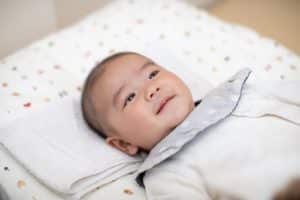
If your baby is only a few weeks old and is embarrassed (seems congested), having difficulty breathing, drinking or sleeping, we can help by first liquefying his secretions with a nasal irrigation and then using a baby nasal aspirator only if necessary. If the baby then clears up on his own by sneezing or swallowing his secretions, you’ve succeeded in helping him. In some cases, you may even notice thicker, more elastic secretions, mucus or phlegm in the baby’s diaper, testifying to the effectiveness of your intervention, without the need for any special equipment.
If the rehydration of secretions hasn’t been enough to clear your baby’s throat, and he’s still uncomfortable, it’s only at this point that we’ll consider moving on to plan B, which is to use a baby nasal aspirator to help him get out the accumulated secretions he can’t get out on his own.
To give a nasal irrigation syringe using the CHU Sainte-Justine technique to a baby under 6 months of age, you must :
- Always wash your hands,
- Remove excess visible secretions before introducing saline solution (use a baby flyer if necessary),
- Fill a syringe with the desired amount (depending on age) of saline solution at room temperature,
- Lay baby on his back or side and swaddle if necessary,
- Turn his head to the side and slide a washcloth under his nose,
- Hold the head firmly with one hand,
- With the other hand, gently irrigate the upper nostril, at a rate of about 1 ml/second, for the entire quantity of liquid in the syringe. Whether you choose the dropper, the vial or the baby spray (e.g. hydraSense®), you must not insert the tip of the tool too far into the nostril. Just touching the edge of the nostril is enough.
- Use 1 ml for premature babies and between 1 and 3 ml of saline water for full-term babies.
- A nasal spray with an ultra-soft jet can also be used. When using, gently insert the nozzle into the top of the nostril and point it towards the outer side of the nostril. You don’t want to aim the spray directly at the back of the throat, which could cause choking.
- Wait a few minutes. You can even lift the baby in your arms if necessary.
- Then repeat the procedure, turning the head to the other side and pouring saline water into the second nostril.
- Wait a few more minutes.
- Observe baby, secretions run from nose, wipe away.
- If the baby clears well like this, we do nothing else.
- If the baby still seems to be stuck in secretions, you can add the use of a baby fly.
- After the age of 6 months, this technique can be performed with baby sitting on you.
If we look more broadly at the recommendations of the learned community regarding the rhythm of preventive nasal cleansing for young babies, we find the following :
- Once a day in summer or as needed for this season, ideally in the evening before the last drink at bedtime,
- 1 to 2 times a day from October to May, and if congestion, colds or disturbing secretions occur, 3 to 6 times a day are no problem, with quantities depending on the child’s age.
Using a nasal bulb or suction bulb
The nasal bulb is an instrument most often used in the first weeks of a baby’s life to remove secretions visible in the nostrils very close to the outlet. It has to be said that the suction power of this tool is not very great, but may be appropriate in this particular case.
It’s important not to confuse a nasal suction bulb with an ear suction bulb. The latter has a longer nozzle whose primary function is to reach further into the ear canal to clean it better, but this tool is not designed for babies, nor for cleaning the nose. Although this type of bulb is used in maternity wards after birth to clear the baby’s back throat of accumulated secretions, the fact remains that its daily use by parents can present certain risks, such as irritating or injuring a baby’s fragile nasal mucosa or the septum that separates the two nostrils.
Proceed with nasal irrigation, and if secretions clear automatically after this first step, stop the clearing procedures.
How do I use the nasal bulb?
- The baby lies on its back with its head to one side.
- If secretions remain sticky and visible in your baby’s nostril, the use of a nasal bulb may help recovery.
- Press firmly on the inflated part of the bulb to extract the air inside, creating the suction power for the rest of the technique, and maintain this pressure without releasing.
- Insert the tip of the mouthpiece into the first nostril, the upper one, far enough to create a seal without forcing.
- Then, gently, gradually release the pressure on the bulb so that it can gently draw out the secretions you want to clear.
- Wipe the nostril and turn the baby’s head to the other side to repeat the procedure in the second nostril.
- Wipe off as needed within a few minutes.
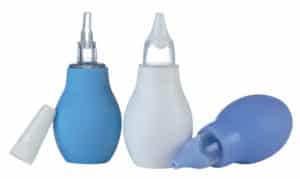
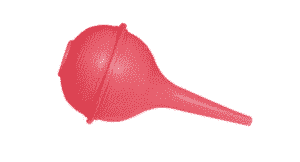
3. Baby fly with mouth suction
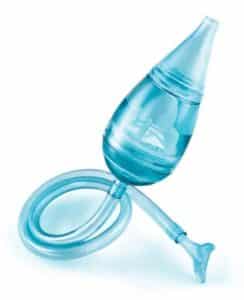 Baby flies with mouth suction first appeared on the market a few years ago. This tool has obviously helped parents to better clear their young children in appropriate situations. However, it is important to know how to use it diligently to avoid injury to the baby.
Baby flies with mouth suction first appeared on the market a few years ago. This tool has obviously helped parents to better clear their young children in appropriate situations. However, it is important to know how to use it diligently to avoid injury to the baby.
At the outset, it’s important to say that it’s preferable to have a baby fly with a soft, supple tip rather than a more rigid one, again to prevent irritation and injury to the nasal mucosa.
This type of nasal aspirator may be suitable for babies over one month of age who remain embarrassed after nasal irrigation. According to the latest data from CHU Sainte-Justine (January 2024), suction is often sufficient to clear a young child. As the child gets older, more suction may be needed to clear the nasal passages, and other models (electric and those connected to the home vacuum cleaner) may be more suitable. The procedure is fairly simple, but involves holding the baby, inserting the mouthpiece into the nose and sucking up secretions through the parent’s mouth.
How do I use a baby fly with mouth suction?
- Lay the baby on his back and turn his head to one side.
- Start by irrigating both nostrils as explained at the beginning of this post.
- Wait a few minutes to see the response to your first procedure.
Then, as needed:
- Place a clean filter in the specially designed cell of the baby fly, as indicated by the manufacturer, and close the cell. This filter stops secretions from flowing up the suction tube and into the parent’s mouth.
- Then rinse the rubber end of the baby fly in warm-hot water to soften it and make it even more supple.
- Position baby correctly for the procedure: lying on his back with his head to one side. Start with the upper nostril and then do the second one by turning the head to the other side.
- Put the end of the suction tube in your mouth.
- Place the tip of the soft tip in the baby’s upper nostril,
- At the same time, you gradually inhale through your mouth.
- Secretions accumulate in the cell, stopped by the filter.
- The baby can then be returned to a more seated position to drain off any remaining fluid and secretions, while gently wiping the baby’s nostrils.
- Then repeat the technique for the second nostril.
- Remove the dirty filter at the end of the procedure, rinse and replace with a new filter ready for the next use.
4. The battery-powered baby fly
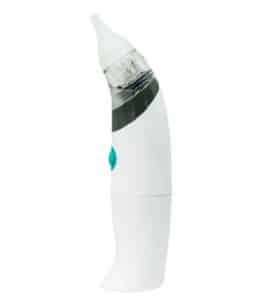 The battery-powered baby fly is a very interesting innovation, as it makes continuous sucking much simpler. The battery-powered baby fly is unique and can be easily contained in the parent’s hand. There’s no tube, no filter, no hose, nothing lying around to interfere with or complicate the technique.
The battery-powered baby fly is a very interesting innovation, as it makes continuous sucking much simpler. The battery-powered baby fly is unique and can be easily contained in the parent’s hand. There’s no tube, no filter, no hose, nothing lying around to interfere with or complicate the technique.
How do I use a battery-powered baby fly?
- The initial procedure is always the same: nasal irrigation in both nostrils.
If necessary, continue the procedure:
- Choose the size of silicone tip according to baby’s nostril size and shape.
- Ideally, place the baby a little more upright than lying flat.
- Hold baby’s head firmly.
- Insert the silicone tip over the rim of baby’s first nostril, pointing outwards from the nostril, without blocking the entire nostril.
- Press the fly’s power button and the suction will start.
- While the device is running, wait a few seconds to see the result of our intervention, then release the button and gently withdraw the device.
- Repeat for the other nostril.
- Wipe the baby’s nose with the run-off,
- Clean according to the manufacturer’s instructions.
Watch out for the Baby-Vac!

At the outset, it’s important to note that sales of this type of baby fly have been suspended for nearly 4 years (Source: Health Canada 2023). A review, including additional medical tests, has been requested to ensure that it is safe for use on babies.
“No parent should use this kind of baby fly, which you plug into a vacuum cleaner”, Dr. Chicoine , Protégez-vous, issue 2023.
In the same vein, an ENT specialist consulted for this educational post has strong reservations about the use of this type of baby fly, which has a very strong suction that can injure a young child. According to him, the new parent often lacks the full knowledge and skill to perform the appropriate technique, which may ultimately prove more traumatic than beneficial for the baby.
If you currently own and use a nasal aspirator connected to a domestic sweeper with your baby, you should be aware that at present, from a health point of view, we have no official recommendations on its safe use, and that without advice to the contrary, it is considered potentially dangerous, with a high risk of injury to the baby.
In view of this, and for reasons of health prevention, we do not recommend this device to parents.
The baby fly technique, regardless of the safe model, can be repeated several times a day as needed.
It’s very important to say that if the baby’s condition doesn’t improve, or if the symptoms of congestion seem to worsen or persist over time despite the clearing interventions performed, it’s best to consult a health professional.
That’s it, we’ve covered it all, to help you make informed choices and intervene effectively with your baby in the event of congestion.
Article updated: November 2024.
Marie Fortier
The baby expert
Written in collaboration with
Dr. Claude Arsenault, family physician
To complete your knowledge on the subject, read those articles:
Or watch those videos:
- Cleaning an infant’s respiratory tract (french only)
- Congestion and the baby
- What to do to reduce baby’s cough
Associate
Dr. Claude Arsenault, family physician

